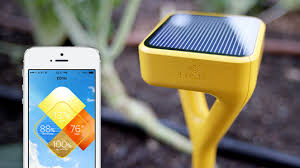fortune.com

At this year’s South by Southwest festival in Austin, the
Internet of things is all the rage. Here are five gadgets up for the event’s
innovation award.
At this year’s South by Southwest festival, you won’t be
able to walk too far in downtown Austin, Texas without seeing or hearing about
a new Internet-connected product—a node in the so-called Internet of things.
Intelligent home devices are among the more popular topics
at the Interactive portion of SXSW this year, the subject of panel discussions
and pop-up exhibits alike. Some may be the next big thing; some may be a flash
in the pan.
Here are five products—all finalists in the IOT category for
this year’s SXSW Interactive Innovation Awards—worth checking out. The winner
will be announced the evening of March 17.
Aether Cone. Standalone speakers for streaming services such
as Rdio, the Cone’s stream of choice, are hardly unusual. What makes the $399
Cone different is that it’s designed to learn your habits and choose
appropriate music for the moment. Prefer to listen to something smooth as you
ease into your day? Cone will remember that. Need some hard rock to power
through a sleepy afternoon? It’s on the case.

Clever Buoy. In Australia, sharks are serious business. The
country has four times more fatal shark attacks than any other—and detection
methods like shark nets and aerial patrols can only do so much. Optus’ Clever
Buoy applies sonar imaging technology to the ocean floor, which returns the
data to a floating buoy. Technology within the spherical object then analyzes
the data and transmits it in real time to overhead satellites. If there’s a
risk, those satellites instantly send out warnings to lifeguards (as well as to
opted-in Google+ accounts, curiously) to keep people away from the water. In
the long term, the company hopes to use the buoys to study all marine wildlife,
on topics such as migratory patterns.

Guide Dots. Seeing-eye dogs and canes can help visually
impaired people avoid obstacles on the street, but they can’t tell them the
name of the business they are walking by. Guide Dots uses smartphones and audio
prompts to let blind people get a better sense of their surroundings, using Google
Places, Facebook’s Nearby functionality and some proprietary data to call out
store names as you walk by them. While that’s certainly handy for commercial
purposes, it also lets them know when Braille-enabled crosslights, ATMs or
other devices are nearby. The service also has a crowdsourcing element, letting
users note path obstructions, and alerting them if friends have recently
checked in to locations.

Hammerhead. There are plenty of apps to chart an exercise
route; Hammerhead takes it a step further for bike riders, specifically. It’s a
physical device that attaches to a bicycle’s handlebars and works in
conjunction with a mobile app to create a course with bike paths and safe
routes in mind. Instead of forcing riders to read directions as they ride, the
T-shaped device (which is available for pre-order for $85) guides them along
their way with an easy-to-understand series of lights. And should they make a
wrong turn, it will show how to get back on track. Hammerhead also works as a
bike light to ensure safety during night rides.

Sprinkl. Current sprinklers waste more water than they use.
Sprinkl is a smart system that downloads weather information and knows when
rain is coming your way, automatically adjusting your watering schedule.
Similarly, it stays up to date on watering restrictions, helping you avoid
fines. And with a series of in-ground sensors, the system adjusts how much
water hits certain areas, avoiding over-watering, which can kill grass and
needlessly run up your bill. The still-in-development system fell short on
Kickstarter, but it’s hoping SXSW recognition can get it back on track.

No comments:
Post a Comment